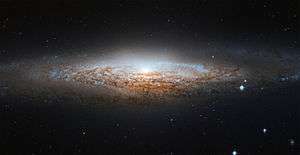NGC 2683
| NGC 2683 | |
|---|---|
|
NGC 2683 spiral galaxy | |
| Observation data (J2000 epoch) | |
| Constellation | Lynx |
| Right ascension | 08h 52m 41.3s[1] |
| Declination | +33° 25′ 19″[1] |
| Redshift | 411 ± 1 km/s[1] |
| Distance | 25 ± 4 Mly (7.7 ± 1.3 Mpc)[2] |
| Apparent magnitude (V) | 10.6[1] |
| Characteristics | |
| Type | SA(rs)b[1] |
| Apparent size (V) | 9′.3 × 2′.2[1] |
| Other designations | |
| UGC 4641,[1] PGC 24930[1] | |
NGC 2683 is a field spiral galaxy discovered by William Herschel on February 5, 1788. It was nicknamed the "UFO Galaxy" by the Astronaut Memorial Planetarium and Observatory.[3][4] It is viewed nearly edge-on from Earth's location in space and is located between 16 and 25 million light-years away. It is receding from Earth at 410 km/s (250 mi/s), and from the Galactic Center at 375 km/s (233 mi/s).[3] The reddened light from the center of the galaxy appears yellowish due to the intervening gas and dust located within the outer arms of NGC 2683.[5]
Characteristics
While usually considered an unbarred spiral galaxy, recent research suggests it may in fact be a barred spiral galaxy; its bar is hard to see due to its high inclination.[6]
It is also both smaller and less luminous than the Milky Way with very little neutral hydrogen[7][8] or molecular hydrogen[8] and a low luminosity in the infrared, which suggests a currently low rate of star formation.[9]
NGC 2683 is rich in globular clusters, hosting about 300 of them, twice the number found in the Milky Way.[10]
References
- 1 2 3 4 5 6 7 8 "NASA/IPAC Extragalactic Database". Results for NGC 2683. Retrieved 25 November 2006.
- ↑ J. L. Tonry; A. Dressler; J. P. Blakeslee; E. A. Ajhar; et al. (2001). "The SBF Survey of Galaxy Distances. IV. SBF Magnitudes, Colors, and Distances". Astrophysical Journal. 546 (2): 681–693. arXiv:astro-ph/0011223
 . Bibcode:2001ApJ...546..681T. doi:10.1086/318301.
. Bibcode:2001ApJ...546..681T. doi:10.1086/318301. - 1 2 "NGC 2683". NGC Online. SEDS. Retrieved 4 February 2014.
- ↑ Materne, J. (April 1979). "The structure of nearby groups of galaxies - Quantitative membership probabilities". Astronomy and Astrophysics. 74 (2): 235–243. Bibcode:1979A&A....74..235M.
- ↑ Matthews, Doug; Block, Adam (15 November 2004). "Best of AOP: NGC 2683". Retrieved 12 October 2010.
- ↑ Kuzio de Naray, Rachel; Zagursky, Matthew J.; McGaugh, Stacy S. (2009). "Kinematic and Photometric Evidence for a Bar in NGC 2683". The Astronomical Journal. 138 (4): 1082–1089. arXiv:0908.0741
 . Bibcode:2009AJ....138.1082K. doi:10.1088/0004-6256/138/4/1082.
. Bibcode:2009AJ....138.1082K. doi:10.1088/0004-6256/138/4/1082. - ↑ Karachentsev, Igor D.; Karachentseva, Valentina E.; Huchtmeier, Walter K.; Makarov, Dmitry I. (2003). "A Catalog of Neighboring Galaxies". The Astronomical Journal. 127 (4): 2031–2068. Bibcode:2004AJ....127.2031K. doi:10.1086/382905.
- 1 2 "A new catalogue of ISM content in normal galaxies.". Retrieved 2012-12-25.
- ↑ Pompei, E.; Terndrup, D. M. (1998). David R. Merritt; Monica Valluri; J. A. Sellwood, eds. "The Stellar and Gaseous Kinematics of NGC 2683". Galaxy Dynamics, proceedings of a conference held at Rutgers University, 8-12 Aug 1998. ASP Conference Series (San Francisco: ASP). 182. Bibcode:1999ASPC..182..221P.
- ↑ "Globular Cluster Systems in Galaxies Beyond the Local Grup.". NASA-IPAC Extragalactic Database (NED). Retrieved 2012-07-21.
External links
| Wikimedia Commons has media related to NGC 2683. |
- NGC 2683 on WikiSky: DSS2, SDSS, GALEX, IRAS, Hydrogen α, X-Ray, Astrophoto, Sky Map, Articles and images
- APOD, 5 Feb 2014
Coordinates: ![]() 08h 52m 41.3s, +33° 25′ 19″
08h 52m 41.3s, +33° 25′ 19″

